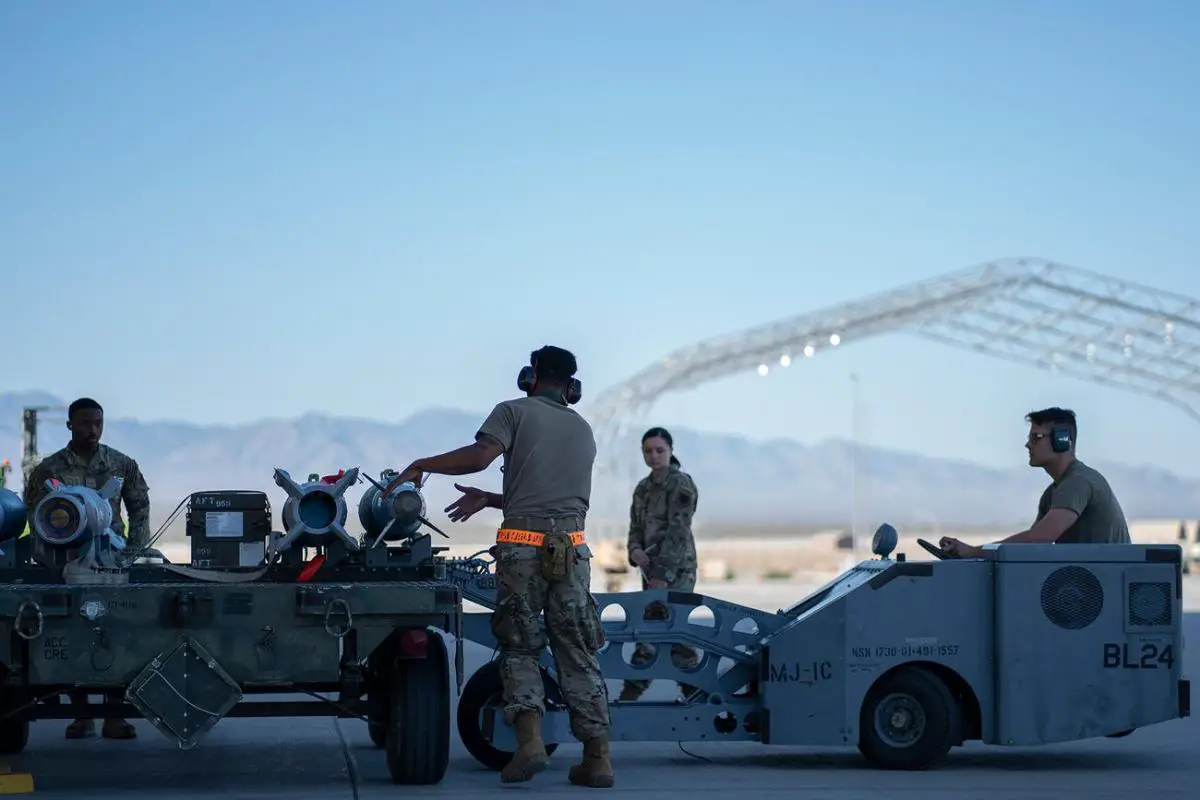An Air Force maintainer was faulted by officials for losing control of a bomb lift truck that struck a parked F-16 Fighting Falcon jet, causing it to erupt into flames last year during a deployment, an accident investigation report revealed.
The incident — which took place in a “undisclosed location in Southwest Asia” — occurred Nov. 17 when the maintainer was operating an MJ-1 vehicle, called a “jammer,” as crew members were loading ammunition onto a parked F-15E Strike Eagle, the report released Friday detailed.
While operating the bomb lift and placing it in reverse, the maintainer had a “loss of situational awareness and confusion” during which he thought he could not stop the vehicle and was accelerating instead of braking. The airman had been familiar with a different model that had a small difference in the location of the pedals, according to the Air Force investigation.
Read Next: Army Sergeant Major’s Chelsea Boots Turn Heads as Service Mulls Allowing Them for Rank and File
The MJ-1 hit the sniper pod of the F-15E, and the maintainer “hit his head and scraped his back” and then went “unconscious,” the report detailed. The airman was thrown from the vehicle, and it hit the Strike Eagle’s landing gear tire, where it shifted direction toward the parked F-16 Fighting Falcon about 60 feet away.
The lift ultimately hit that aircraft’s fuel tank, causing a leak.
“A spark from the … MJ-1 ignited a fire, which engulfed the … MJ-1 and the right front side of the [F-16],” the report states.
While the incident resulted in no fatalities or major injuries, it caused nearly $5,000 in environmental cleanup costs and upward of $30 million in damages to the aircraft, according to the accident investigation board.
One crew member had tried using two other bomb lifts prior to the incident, but one would not start and the other was experiencing gear shifting issues, which led the crew to use the jammer that caused the incident, the report found.
The report also points to other failures such as “a lack of proper documentation for the jammer fleet at the undisclosed location and a loose culture of adherence to Air Force standards and technical procedures by maintainers at the location” as additional factors in the crash, U.S. Air Forces Europe-Air Forces Africa said in a news release.
The report on the incident comes as the Air Force is pushing maintainers to sign nondisclosure agreements, or NDAs, before they can receive privileged safety reports on such mishaps.
In a roundtable with reporters Friday, Maj. Gen. Sean Choquette, the Air Force chief of safety and commander of the Air Force Safety Center, said that recent incidents on the flight line prompted officials to have maintainers sign NDAs and loop them in on safety reports.
The Air Force’s 80,000 maintainers will have access to the reports after signing NDAs, he said.
“We’ve had an increase over the course of last year in what we call aviation ground operations mishaps, so not flying the aircraft, but towing airplanes around the flight line, maintenance work out on the flight line,” Choquette told reporters. “We can’t share all of the lessons-learned information that we have inside the safety privileged system without extending that to them.”
After major mishaps, Air Force officials typically commission two reports: an accident investigation board report and a safety investigation board report.
The former is released to the public while the safety investigation board reports are kept internal, often provide more specifics and details behind the cause of a mishap, and are used to educate service members and officials. Choquette said that internal safety privilege is important in the investigations.
“What safety privilege does is it promises to those individuals that anything that they say can’t be used in disciplinary action and it will not be presented in public in order for them to talk in a fulsome way about what occurred,” Choquette said. “We don’t want to put them in a situation where they feel like they can’t tell the whole story, because it’s going to come out in an article that’s going to be read by their family or their superiors or their subordinates.”
For example, Military.com reported on the accident investigation board findings behind a CV-22 Osprey crash late last year in Japan that claimed the lives of eight airmen. But the news organization also reviewed a copy of the internal safety investigation board report that, unlike the accident investigation board report, revealed prior warnings related to a component that failed on the aircraft a decade ago.
Transparency advocates told Military.com earlier this month that requiring NDAs appeared to be an “effort to intimidate” those in uniform from speaking.
When asked by reporters whether an airman could face administrative action if they revealed safety privileged information under that NDA, Choquette responded, “You bet they could.”
Related: To See Crash Info, Air Force Maintainers Must Now Sign Non-Disclosure Agreements


Leave a Comment